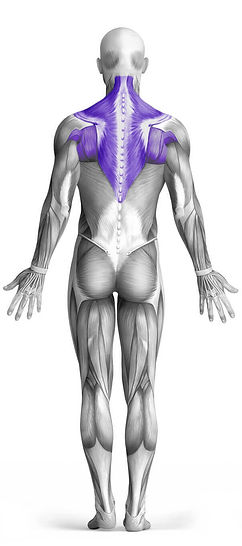Weighted Inverted Row 101 Video Tutorial
0

Timer
Hour
Minute
Second
Stopwatch
00:00:00:00
Overview
The Weighted Inverted Row is an excellent exercise for targeting the upper back, particularly the traps and rhomboids, while also engaging the abs, biceps, lats, lower back, and shoulders. By using rings, this exercise allows for a more dynamic and challenging movement, as it increases the instability compared to using a bar. To perform the exercise, you hang from the rings with your body in a straight line and pull your chest toward the rings, focusing on squeezing the shoulder blades together. Adding weight to this movement helps increase resistance, making it an effective option for building upper body strength and muscle mass.
How to Perform
Set the rings at about chest height, ensuring they are securely fastened.
Position yourself beneath the rings, keeping your legs straight. Place a weight plate on your chest if you're using additional resistance.
Reach up to grab the rings with an overhand grip, ensuring your hands are shoulder-width apart.
Press your heels into the floor and extend your hips forward, making sure your body forms a straight line from head to heels. Your arms should be fully extended, with your torso aligned perpendicular to your arms.
Engage your core, and pull your chest towards the rings by driving your elbows back, keeping them elevated as you squeeze your shoulder blades together.
Slowly lower yourself back down to the starting position with control, resisting gravity to maintain tension on your muscles.
Repeat the movement for the desired number of reps, focusing on maintaining a steady, controlled motion throughout.
★ Bonus: For exercises that involve external weights (such as dumbbells, barbells, or machines), the One Rep Max (1RM) calculator can help you estimate your maximum lifting capacity. Use it to track your strength progress and adjust your training for optimal results.
Tips
To modify the difficulty of the exercise, adjust the height of the rings. The closer you are to being parallel with the floor, the more challenging the movement becomes.
If you don't have access to weight plates, a weight vest is a good alternative. In the absence of a vest, an old backpack can work, but be sure to load it on the front of your body to avoid excessive arching and pulling into extension.
For more advanced variations, you can incorporate fat grips to increase grip strength or try single-arm inverted rows. However, always prioritize proper form over difficulty. Challenging yourself is valuable, but progression should only occur once you've mastered the basic movement.
While performing the exercise, avoid letting your head jut forward. Focus on maintaining a neutral spine throughout the motion.
Keep your ribcage down and resist the urge to excessively arch your back or force your chest upward.
Ensure that your body forms a straight line from your head to your heels, with no sagging in the hips or lower back.
How Not to Perform
Avoid Arching the Back: Do not excessively arch your lower back as you pull yourself up. Keep your core engaged to maintain a neutral spine and avoid placing unnecessary strain on your lower back.
Don’t Let Your Hips Sag: Ensure that your body remains in a straight line from head to heels. Letting your hips sag will shift the focus away from the upper back and increase the risk of lower back strain.
Do Not Use Momentum: Avoid swinging your body or using momentum to complete the movement. Focus on controlled, smooth movements to target the upper back muscles effectively and prevent wasting energy.
Avoid Pulling with Your Arms Only: Don’t rely solely on your arms to lift your body. Engage your back muscles, particularly the traps and lats, by pulling with your elbows and squeezing your shoulder blades together. This will maximize the effectiveness of the exercise.
Don’t Let Your Elbows Drop: Keep your elbows high and aligned with your shoulders throughout the movement. Dropping your elbows can reduce the activation of the upper back muscles and place strain on your shoulders.
Avoid Hyperextending the Neck: Do not crane your neck forward when pulling yourself up. Keep your head in a neutral position to avoid straining your neck and to maintain proper alignment.
Don’t Overextend the Range of Motion: While it’s important to lower yourself fully, don’t push your chest too far up or back excessively. This can cause unnecessary strain on the shoulders and reduce the focus on the targeted muscles.
Avoid Shrugging the Shoulders: Don’t let your shoulders ride up towards your ears. Maintain relaxed, stable shoulders and focus on retracting the scapula to activate the upper back muscles effectively.
Don’t Rush Through Repetitions: Perform each rep with control and focus. Avoid rushing, as this can lead to improper form and less effective targeting of the muscles.
Don’t Let the Rings Swing: Ensure the rings stay stable throughout the movement. Letting the rings swing back and forth increases instability and reduces the effectiveness of the exercise.
Variations
Variations of fitness exercises refer to different ways of performing a specific exercise or movement to target various muscle groups, intensities, or goals. These variations aim to challenge the body differently, prevent plateaus, and cater to individuals with varying fitness levels.
Alternatives
Alternative exercises in fitness refer to different movements or activities that target similar muscle groups or serve the same training purpose as the primary exercise. These alternative exercises can be used as substitutes when the original exercise is unavailable or challenging to perform due to various reasons such as equipment limitations, injuries, or personal preferences.








